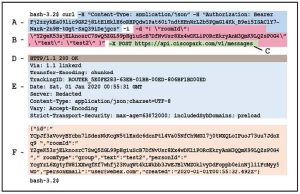
The latest 200-301 Practice Exam are the most suitable method for Cisco CCNA(V1.1) exam success and are suitable for all candidates!
Cisco 200-301 CCNA Exam Success Methodology has many:
- Purchase learning videos
- Participate in discussion groups
- Buy books for self-study
- Participate in an official training program
- Find free exam resources
- *Using Cisco 200-301 Practice Exam: https://www.leads4pass.com/200-301.html (1652 Q&A)
No matter what method you use, the ultimate goal is to successfully pass the exam and obtain CCNA certification! Among all the methods, Cisco 200-301 Practice Exam is strongly recommended, because it is carefully edited, reviewed, corrected, and successfully passed the practical test by the Cisco professional team. It is a real and effective material! And contains two learning formats, PDF and VCE,
You can choose arbitrarily, both formats contain the latest CCNA exam questions and answers!
And share the latest Cisco CCNA(V1.1) 200-301 Practice Exam questions online
| From | Number of exam questions | Associated certification | Online Download |
| Leads4pass | 15 (Free) | CCNA | 200-301 PDF |
New Question 1:
Refer to the exhibit.
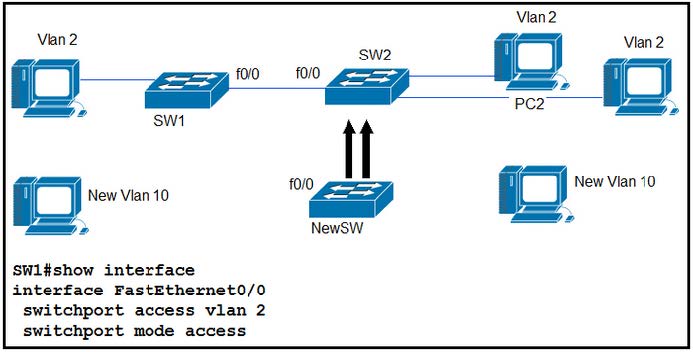
An engineer is configuring a new Cisco switch NewSW, to replace SW2 The details have been provided
1.
Switches SW1 and SW2 are third-party devices without support for trunk ports
2.
The existing connections must be maintained between PC1 PC2 and PC3
3.
Allow the switch to pass traffic from future VLAN 10.
Which configuration must be applied?
A. NewSW(config)#interface f0/0 NewSW(config-if)#switchport mode trunk NewSW(config-if)#switchport trunk native vlan 10 NewSW(config-if)#switchport trunk native vlan 10
B. NewSW(config)#interface f0/0 NewSW(config-if)#switchport mode access
NewSW(config-if)#switchport trunk allowed vlan 2, 10
NewSW(config-if)#switchport trunk native vlan 2
C. NewSW(config)#interface f0/0 NewSW(config-if)#switchport mode access NewSW(config-if)#switchport trunk allowed vlan 2, 10 NewSW(config-if)#switchport trunk native vlan 10
D. NewSW(config)#interface f0/0 NewSW(config-if)#switchport mode trunk NewSW(config-if)#switchport trunk allowed vlan 2, 10 NewSW(config-if)#switchport trunk native vlan 2
Correct Answer: D
Explanation:
Nothing says that the new switch doesn\’t allow trunking. It can´t be B, because when you configure the port in access mode it doesn´t evaluate the trunking commands, and access only permits one vlan.
If you have access on one side the vlan comes untagged, for the other side to put this untagged vlan in a native vlan the port needs to be configured as trunk. Also this imposes that in the future to have vlan 10 passing here you would need to replace SW1 to have trunk funcionality or alternatively configure another uplink to pass vlan 10 the same way to new SW.
New Question 2:
Refer to the exhibit. When router R1 receives a packet with destination IP address 10.56.0.62, through which interface does it route the packet?
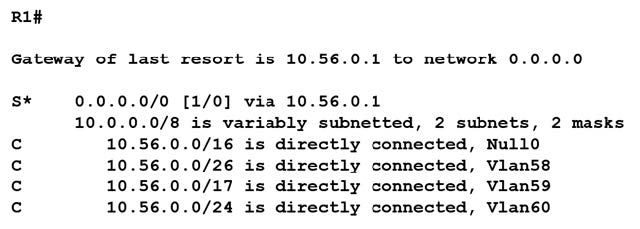
A. Null0
B. VIan58
C. Vlan60
D. VIan59
Correct Answer: B
Explanation:
mask /26 seems 2^6 = 64 ,so 10.56.0.0/26 means 10.56.0.0 ~ 10.56.0.63 is the range,the broadcast is 10.56.0.63 and 10.56.0.62 is the final address can be used refer to the routing table, /26 go to vlan 58
New Question 3:
Refer to the exhibit. Traffic that is flowing over interface TenGigabitEthernet0/0 experiences slow transfer speeds. What is the reason for the issue?
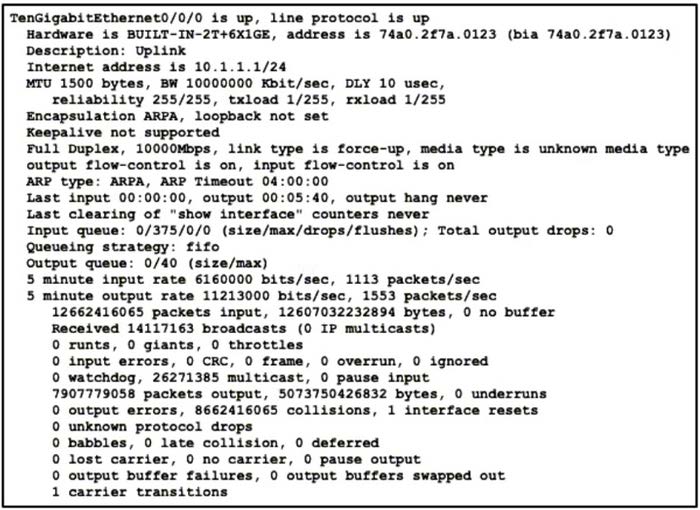
A. heavy traffic congestion
B. a duplex incompatibility
C. a speed conflict
D. queuing drops
Correct Answer: B
Explanation:
According to OCG and Boson practice exams, collisions are duplex incompatibility.
New Question 4:
Refer to the exhibit.
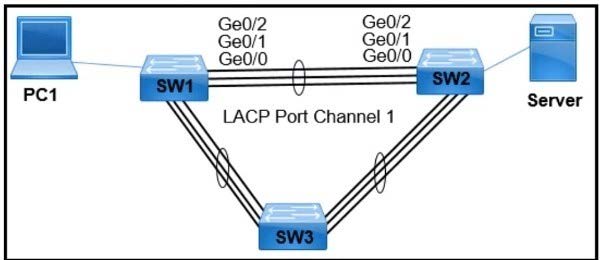
PC1 regularly sends 1800 Mbps of traffic to the server. A network engineer needs to configure the EtherChannel to disable Port Channel 1 between SW1 and SW2 when the Ge0/0 and Ge0/1 ports on SW2 go down. Which configuration must the engineer apply to the switch?
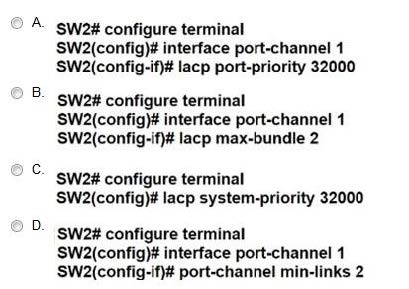
A. Option A
B. Option B
C. Option C
D. Option D
Correct Answer: D
New Question 5:
A switch is forwarding a frame out of all interfaces except the interface that received the frame. What is the technical term for this process?
A. ARP
B. CDP
C. flooding
D. multicast
Correct Answer: C
New Question 6:
Refer to the exhibit.
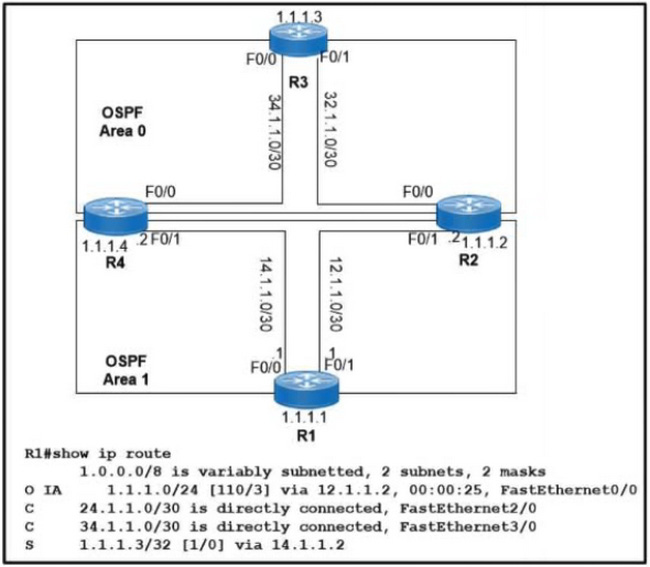
Which two values does router R1 use to determine the best path to reach destinations in network 1,0.0.0/8? (Choose two.)
A. longest prefix match
B. highest administrative distance
C. highest metric
D. lowest metric
E. lowest cost to reach the next hop
Correct Answer: BE
Explanation:
The two values that router R1 uses to identify valid routes for the R3 loopback address 1.1.1.3/32 are:
Lowest cost to reach the next hop: Router R1 will look for the route with the lowest cost to reach the next hop, as determined by the routing protocol being used. This is typically the metric or cost associated with the path to the next hop.
Lowest administrative distance: If there are multiple routes with the same cost, router R1 will use the administrative distance to determine the best path. The administrative distance is a value assigned to each routing protocol that indicates
the reliability of the routing information. A lower administrative distance indicates a more reliable source of routing information.
New Question 7:
DRAG DROP
Drag and drop the WLAN components from the left onto the correct descriptions on the right.
Select and Place:

Correct Answer:

Explanation:
The service port can be used management purposes, primarily for out-of-band management. However, AP management traffic is not possible across the service port.
In most cases, the service port is used as a “last resort” means of accessing the controller GUI for management purposes.
For example, in the case where the system distribution ports on the controller are down or their communication to the wired network is otherwise degraded.
A dynamic interface with the Dynamic AP Management option enabled is used as the tunnel source for packets from the controller to the access point and as the destination for CAPWAP packets from the access point to the controller.
The virtual interface is used to support mobility management, Dynamic Host Configuration Protocol (DHCP) relay, and embedded Layer 3 security such as guest web authentication.
It also maintains the DNS gateway host name used by Layer 3 security and mobility managers to verify the source of certificates when Layer 3 web authorization is enabled.
New Question 8:
Which channel-group mode must be configured when multiple distribution interfaces connected to a WLC are bundled?
A. Channel-group mode passive.
B. Channel-group mode on.
C. Channel-group mode desirable.
D. Channel-group mode active.
Correct Answer: B
New Question 9:
Guidelines
This is a lab item in which tasks will be performed on virtual devices
1.
Refer to the Tasks tab to view the tasks for this lab item.
2.
Refer to the Topology tab to access the device console(s) and perform the tasks
3.
Console access is available for all required devices by clicking the device icon or using the tab(s) above the console window
4.
All necessary preconfigurations have been applied
5.
Do not change the enable password or hostname for any device
6.
Save your configurations to NVRAM before moving to the next item
7.
Click Next at the bottom of the screen to submit this lab and move to the next question
8.
When Next is clicked, the lab closes and cannot be reopened
Connectivity between four routers has been established. IP connectivity must be configured in the order presented to complete the implementation. No dynamic routing protocols are included.
1.
Configure static routing using host routes to establish connectivity from router R3 to the router R1 Loopback address using the source IP of 209.165.200.230.
2.
Configure an IPv4 default route on router R2 destined for router R4.
3.
Configure an IPv6 default router on router R2 destined for router R4.
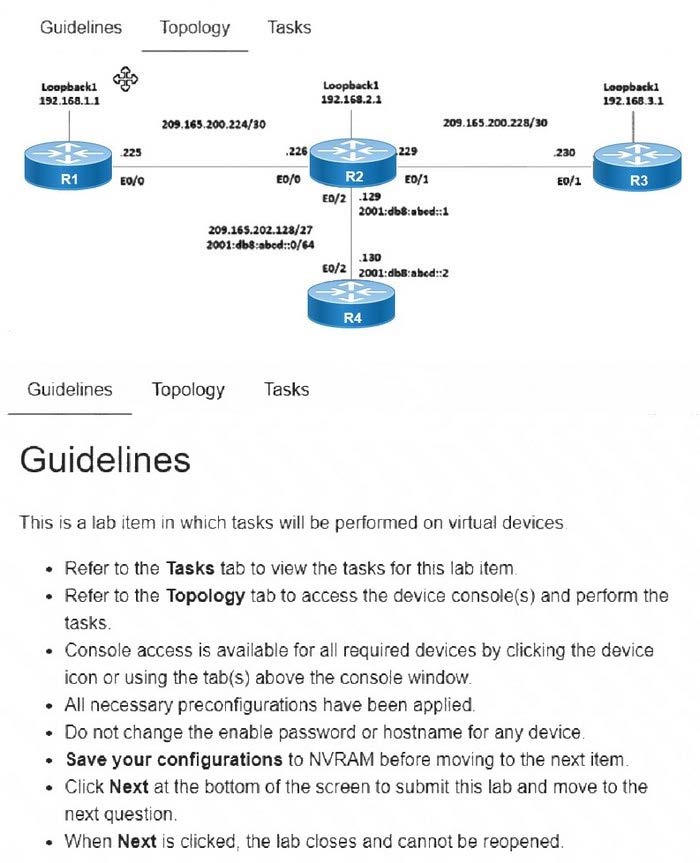
A. Check the below
B. Place Holder
C. Place Holder
D. Place Holder
Correct Answer: A
Explanation:
1.- on R3
config terminal ip route 192.168.1.1 255.255.255.255 209.165.200.229 end copy running start
2.- on R2
config terminal ip route 0.0.0.0 0.0.0.0 209.165.202.130 end copy running start
3.- on R2
config terminal ipv6 route ::/0 2001:db8:abcd::2 end copy running start
New Question 10:
Two switches have been implemented and all interfaces are at the default configuration level. A trunk link must be implemented between two switches with these requirements:
1.
using an industry-standard trunking protocol
2.
permitting VLANs 1-10 and denying other VLANs
How must the interconnecting ports be configured?
A. switchport mode dynamicchannel-protocol lacpswitchport trunk allowed vlans 1-10
B. switchport mode trunkswitchport trunk allowed vlans 1-10switchport trunk native vlan 11
C. switchport mode trunkswitchport trunk encapsulation dot1qswitchport trunk allowed vlans 1-10
D. switchport mode dynamic desirablechannel-group 1 mode desirableswitchport trunk encapsulation islswitchport trunk allowed vlan except 11-4094
Correct Answer: C
New Question 11:
Refer to the exhibit.
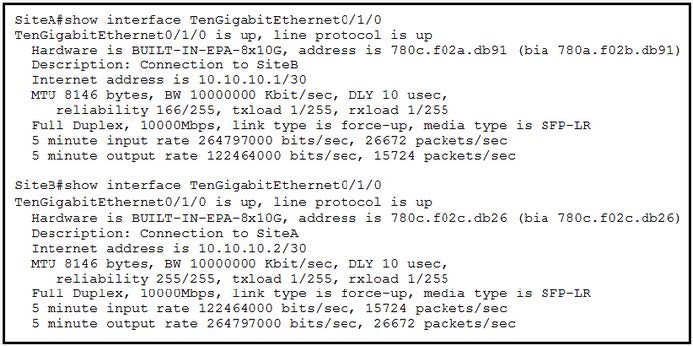
Shortly after SiteA was connected to SiteB over a new single-mode fiber path users at SiteA report intermittent connectivity issues with applications hosted at SiteB What is the cause of the intermittent connectivity issue?
A. Interface errors are incrementing
B. An incorrect SFP media type was used at SiteA
C. High usage is causing high latency
D. The sites were connected with the wrong cable type
Correct Answer: A
Explanation:
reliability 255/255: When the input and output errors increase, they affect the reliability counter. This indicates how likely it is that a packet can be delivered or received succesfully. Reliability is calculated like this: reliability = number of packets / number of total frames. The value of 255 is the highest value meaning that the interface is very reliable at the moment. The calculation above is done every 5 minutes.
New Question 12:
Which state is bypassed in Rapid PVST+ when PortFast is enabled on a port?
A. blocking
B. forwarding
C. learning
D. discarding
Correct Answer: C
New Question 13:
Refer to the exhibit.
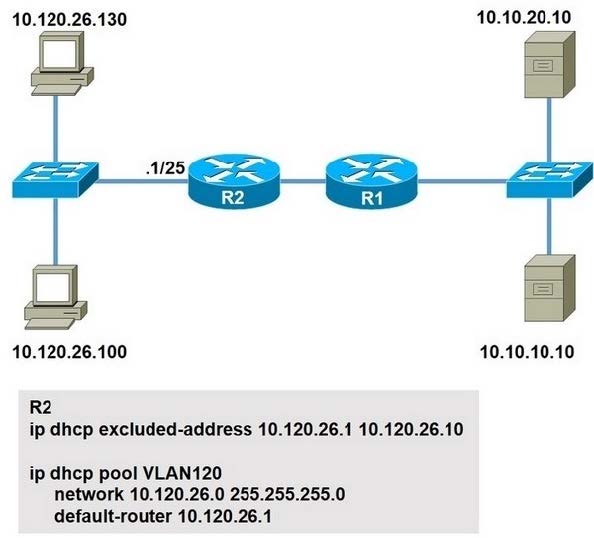
Users in your office are complaining that they cannot connect to the severs at a remote site. When troubleshooting, you find that you can successfully reach the severs from router R2.
What is the most likely reason that the other users are experiencing connection failure?
A. interface ports are shut down on the remote servers
B. The DHCP address pool has been exhausted
C. The ip helper-address command is missing on the R2 interface that connects to the switch
D. VLSM is misconfigured between the router interface and the DHCP pool.
Correct Answer: D
New Question 14:
Which type of attack can be mitigated by dynamic ARP inspection?
A. worm
B. malware
C. DDoS
D. man-in-the-middle
Correct Answer: D
New Question 15:
Which action implements physical access control as part of the security program of an organization?
A. setting up IP cameras to monitor key infrastructure
B. configuring a password for the console port
C. backing up syslogs at a remote location
D. configuring enable passwords on network devices
Correct Answer: A
Explanation:
Physical access control: Infrastructure locations, such as network closets and data centers, should remain securely locked.
Badge access to sensitive locations is a scalable solution, offering an audit trail of identities and timestamps when access is granted.
Administrators can control access on a granular basis and quickly remove access when an employee is dismissed. (Official-Cert-Guide-Volume-2)
…
Final conclusion:
The best way for Cisco 200-301 CCNA exam to succeed is to use Leads4pass 200-301 Practice Exam: https://www.leads4pass.com/200-301.html,
Because all exam questions are verified by a Cisco professional team, they are real and effective! 100% guarantee to help you pass the Cisco 200-301 CCNA exam.
Copyright Notice: The original article was edited and published by trainingolives.com with the consent of Leads4pass! Anyone who copies it is a pirated copy.
